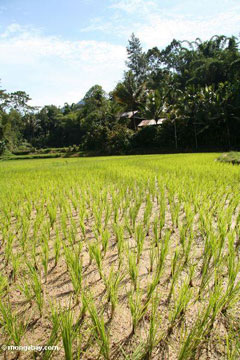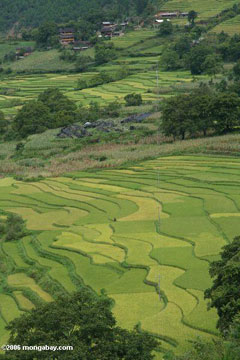Global warming to hurt agriculture in world’s poorest regions
Global warming to hurt agriculture in world’s poorest regions
mongabay.com
January 31, 2008
|
|
Global warming wil cause severe crop losses in some of the poorest parts of Africa and Asia by 2030, reports a study published in tomorrow’s issue of the journal Science.
Analyzing 20 climate change models for 12 of the world’s most impoverished regions and comparing crop yields from past climate variability, researchers from Stanford University’s Program on Food Security and the Environment (FSE) found that Southern Africa and South Asia are likely to see the greatest crops losses due to rising temperatures and falling precipitation levels.
“We were surprised by how much and how soon these regions could suffer if we don’t adapt,” said study co-author Marshall Burke, a researcher at FSE. “For example, our study suggests that Southern Africa could lose more than 30 percent of its main crop, maize, in the next two decades, with possibly devastating implications for hunger in the region.”
The researchers estimate at least a 10 percent loss of regional staples, including millet, maize and rice, in South Asia.

|
Adapting agriculture to climate change
Given the dire outlook, adapting agriculture to climate change is a critical priority say the authors.
“By looking systematically across regions and at a wide range of crops of importance to the poor, we hope to provide a way to prioritize investments in adaptation,” said lead author David Lobell, a senior research scholar at FSE. “Say you’re an organization with finite resources that’s interested in alleviating hunger and concerned about the effects of climate change. Our study asks, given the data we have, where would you spend your money first? And while the data are not perfect, we have to make decisions based on available data.”
“The biggest benefits will likely result from… the development of new crop varieties and expansion of irrigation,” the authors write. “These adaptations will require substantial investments by farmers, governments, scientists and development organizations, all of whom face many other demands on their resources.”
Given the high levels of uncertainty in some regions, the authors say institutions will face difficult decisions in where to allocate limited funds.
“There are the sure bets, such as maize in Southern Africa and rice in Southeast Asia, where all models agree that impacts will be negative,” Lobell said. “Then there are those cases where things could get really bad, such as for sorghum in the Sahel or millets in Central Africa, but where we are less certain. In the end, if a choice has to be made, individual institutions will have to decide for themselves whether to pursue the sure bets or the riskier but potentially high-payoff investments.”
“The majority of the world’s 1 billion poor depend on agriculture for their livelihoods,” continued Lobell. “Unfortunately, agriculture is also the human enterprise most vulnerable to changes in climate. Understanding where these climate threats will be greatest, for what crops and on what time scales, will be central to our efforts at fighting hunger and poverty over the coming decades.”
D.B. Lobell et al. (2008). Prioritizing climate change adaptation needs for food security in 2030. Science 1-Feb-2008
